Synergistic anti-tumor effect of combined inhibition of EGFR and JAK/STAT3 pathways in human ovarian cancer
- PMID: 25928246
- PMCID: PMC4437681
- DOI: 10.1186/s12943-015-0366-5
Synergistic anti-tumor effect of combined inhibition of EGFR and JAK/STAT3 pathways in human ovarian cancer
Abstract
Background: The EGFR signaling pathway is frequently activated in human ovarian cancer and associated with poor prognosis. However, inhibition of EGFR signaling in patients with recurrent ovarian cancer has been disappointing. It remains to be addressed whether ovarian cancer patients could benefit from targeting EGFR signaling. Here we investigated the mechanisms underlying the resistance to EGFR inhibition in ovarian cancer and developed a strategy to overcome it.
Results: We found that treatment of human ovarian cancer cells with an EGFR inhibitor, gefitinib, resulted in increased STAT3 phosphorylation in a dose- and time-dependent manner. Inhibiting STAT3 activation with a small molecule inhibitor of JAK, an upstream kinase that phosphorylates and activates STAT3, synergistically increased the anti-tumor activity of gefitinib in vitro. Similar results were obtained when STAT3 or JAK1 expression was knocked down. In contrast, inhibiting other signaling pathways, such as AKT/mTOR, MEK or SRC, was relatively less effective. The combined treatment resulted in simultaneous attenuation of multiple survival pathways and increased inhibition of ERK pathway. In addition, the dual inhibition showed a stronger suppression of xenograft tumor growth than either single inhibition.
Conclusions: Our findings demonstrate that feedback activation of STAT3 pathway might contribute to the resistance to EGFR inhibition. Combined blockade of both pathways appears to be more effective against human ovarian cancer than inhibition of each pathway alone both in vitro and in vivo. This study may provide a strategy to improve clinical benefit of targeting EGFR pathway in ovarian cancer patients.
Figures
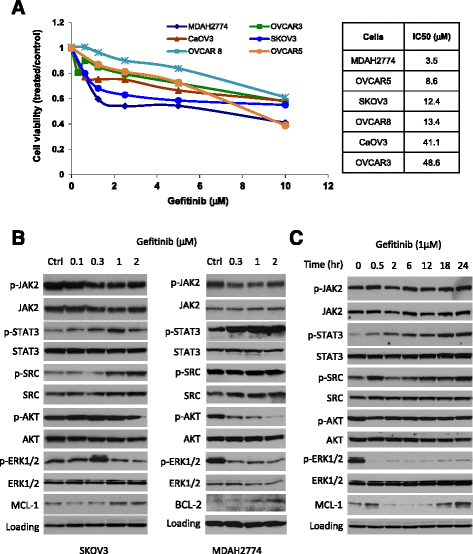
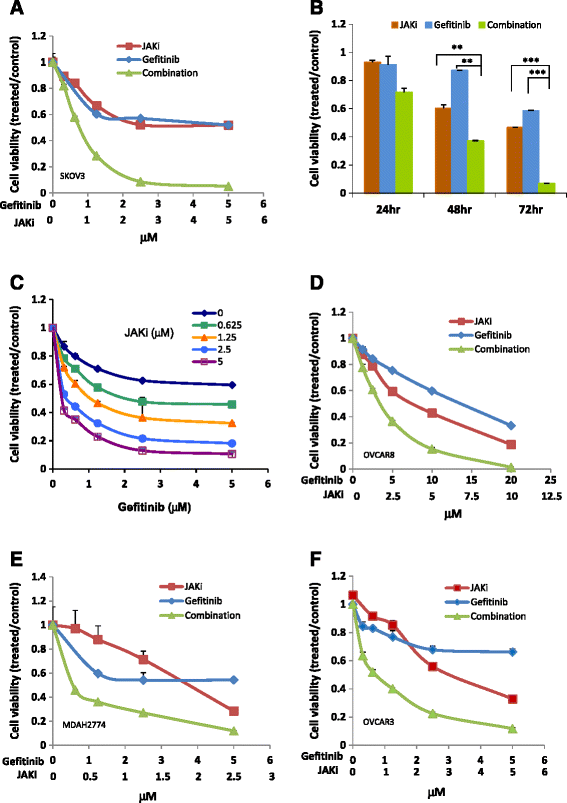
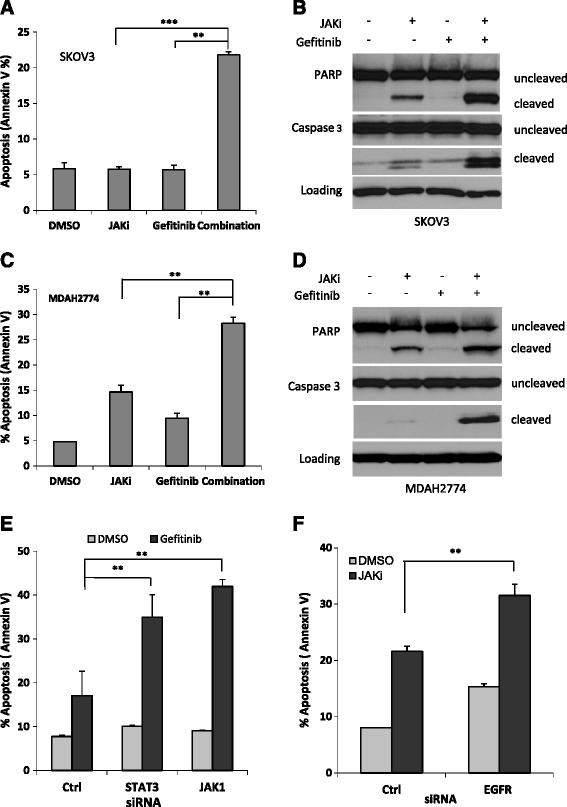
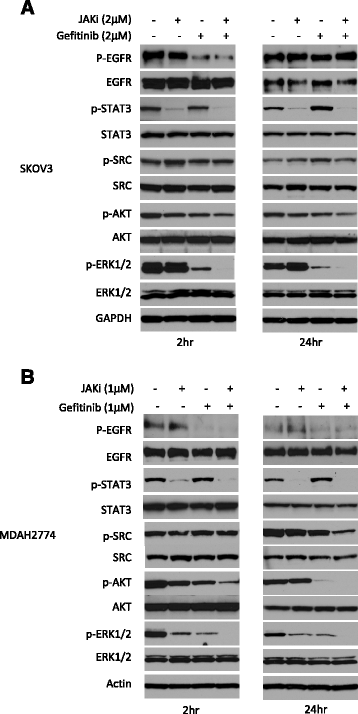
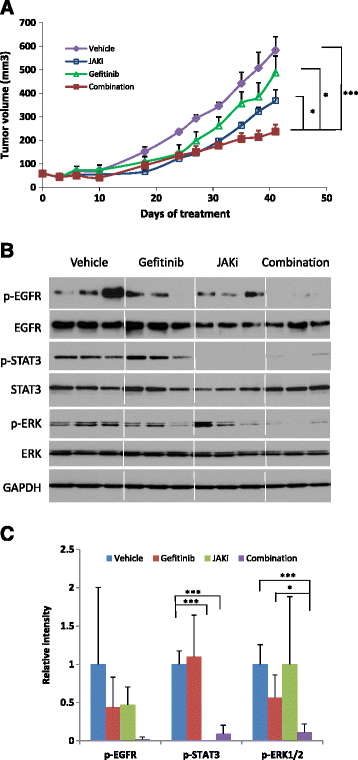
Similar articles
-
Overcoming resistance of targeted EGFR monotherapy by inhibition of STAT3 escape pathway in soft tissue sarcoma.Oncotarget. 2016 Apr 19;7(16):21496-509. doi: 10.18632/oncotarget.7452. Oncotarget. 2016. PMID: 26909593 Free PMC article.
-
Combined epidermal growth factor receptor targeting with the tyrosine kinase inhibitor gefitinib (ZD1839) and the monoclonal antibody cetuximab (IMC-C225): superiority over single-agent receptor targeting.Clin Cancer Res. 2004 Oct 1;10(19):6487-501. doi: 10.1158/1078-0432.CCR-04-0870. Clin Cancer Res. 2004. PMID: 15475436
-
Dasatinib + Gefitinib, a non platinum-based combination with enhanced growth inhibitory, anti-migratory and anti-invasive potency against human ovarian cancer cells.J Ovarian Res. 2017 Apr 26;10(1):31. doi: 10.1186/s13048-017-0319-2. J Ovarian Res. 2017. PMID: 28446239 Free PMC article.
-
Defining the role of the JAK-STAT pathway in head and neck and thoracic malignancies: implications for future therapeutic approaches.Drug Resist Updat. 2010 Jun;13(3):67-78. doi: 10.1016/j.drup.2010.04.001. Epub 2010 May 14. Drug Resist Updat. 2010. PMID: 20471303 Review.
-
Targeting JAK kinase in solid tumors: emerging opportunities and challenges.Oncogene. 2016 Feb 25;35(8):939-51. doi: 10.1038/onc.2015.150. Epub 2015 May 18. Oncogene. 2016. PMID: 25982279 Review.
Cited by
-
NHE1 Mediates 5-Fu Resistance in Gastric Cancer via STAT3 Signaling Pathway.Onco Targets Ther. 2020 Aug 24;13:8521-8532. doi: 10.2147/OTT.S256274. eCollection 2020. Onco Targets Ther. 2020. PMID: 32904684 Free PMC article.
-
Proteomic analysis of canine oral tumor tissues using MALDI-TOF mass spectrometry and in-gel digestion coupled with mass spectrometry (GeLC MS/MS) approaches.PLoS One. 2018 Jul 12;13(7):e0200619. doi: 10.1371/journal.pone.0200619. eCollection 2018. PLoS One. 2018. PMID: 30001383 Free PMC article.
-
Bazedoxifene as a Novel GP130 Inhibitor for Pancreatic Cancer Therapy.Mol Cancer Ther. 2016 Nov;15(11):2609-2619. doi: 10.1158/1535-7163.MCT-15-0921. Epub 2016 Aug 17. Mol Cancer Ther. 2016. PMID: 27535971 Free PMC article.
-
Lapatinib‑induced inhibition of ovarian function is counteracted by the STAT3 pathway both in vivo and in vitro.Oncol Rep. 2020 Sep;44(3):1127-1135. doi: 10.3892/or.2020.7660. Epub 2020 Jun 24. Oncol Rep. 2020. PMID: 32582968 Free PMC article.
-
Unraveling the complexity of STAT3 in cancer: molecular understanding and drug discovery.J Exp Clin Cancer Res. 2024 Jan 20;43(1):23. doi: 10.1186/s13046-024-02949-5. J Exp Clin Cancer Res. 2024. PMID: 38245798 Free PMC article. Review.
References
Publication types
MeSH terms
Substances
Grants and funding
LinkOut - more resources
Full Text Sources
Other Literature Sources
Medical
Research Materials
Miscellaneous

